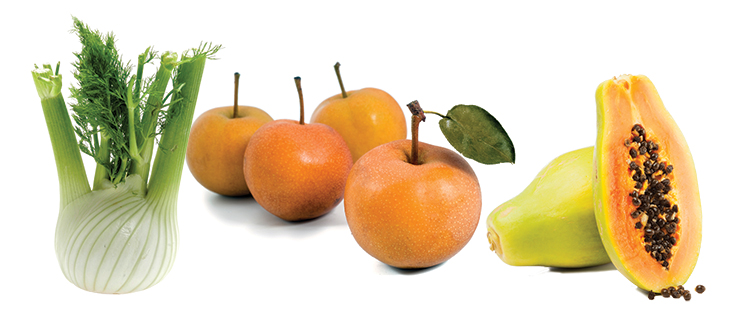by Peggy Paul Casella
Fennel
This herb grows up to 10 feet tall, with finger-like stems that stretch upward from its bulb amidst feathery fronds. As it reaches maturity, the plant produces a canopy of yellow flowers. Like the fronds, stems and bulb, these flowers are entirely edible, boasting a sweet, licorice-like flavor. The two most commonly eaten parts of the fennel plant are the bulb, which is used as a vegetable in savory and sweet dishes, and the seeds, which are used in teas and spice blends. Look for fennel bulbs with stems and fronds in tact, and use the whole thing!
Uses: Slice the bulb and stems, and roast or sauté with other vegetables, or bake them into savory tarts. Serve it raw in a salad with orange segments and green olives; it also pairs extremely well with crisp apples. Crush the seeds and churn them into ice cream, or cook them into custards and other desserts that would benefit from anise-like flavor. Use chopped fronds as a garnish or in place of other herbs like parsley.
Asian Pears
(a.k.a. Japanese Pear, Chinese Pear & apple pear)
Native to China and Japan, where they have been cultivated for thousands of years, Asian pears are plump and round and have a rough skin that can range from yellow to brownish green. As for taste, my husband compares them to those plastic-sheathed freeze pops of childhood: crunchy, juicy and syrupy sweet. They are picked ripe and do not soften like conventional pears, but they are just as susceptible to bruising. And because of their firm texture, they can be subbed in for apples in many different recipes. Look for unblemished fruit that feels heavy for its size. They will keep at room temperature for one week and in the fridge for up to three months.
Uses: Chop or slice them for use in salads and stuffings, grate them into slaws and use them to flavor, and add moisture to cakes, pies and muffins. You can also stuff and roast them as you would apples, cook them down into chutneys and butters, or sauté them to serve with pork chops.
Paw Paws
(a.k.a. Hoosier banana, Indian banana, custard apple & Quaker delight)
Don’t be fooled by the tropical flavor of these greenish black tree fruits— paw paws are actually native to North America. Break into a ripe one and you’ll find custardy yellow flesh that tastes like a mash-up of banana, mango and unfiltered (yeasty) beer. Paw paws are best eaten straight off the tree, and their short shelf life and season makes it difficult for farmers to cultivate and sell them to grocery stores. Thankfully, since these elusive treats grow wild all over the area, you can find foraged paw paws at the farmers market, or you can hunt for them yourself in your local forest.
Uses: You can eat paw paws as is, or squeeze ripe fruit over a colander to make purée, and use it in cakes, cookies and quick breads; over yogurt or vanilla ice cream; or in smoothies, puddings and ice creams.
Peggy Paul Casella is a cookbook editor, writer, urban vegetable gardener, produce peddler and author of the blog Thursday Night Pizza.











